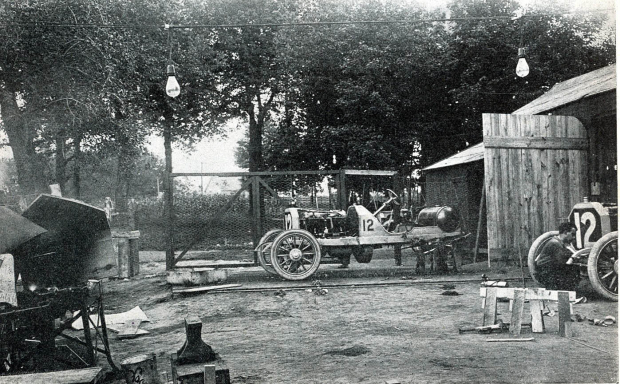The Amazing and Continuing Saga of the 1906 Locomobile Twins- Part II

In response to Dean B's email, last Sunday, I started the story of the 1906 Locomobile twins. Here's a recap and Part II.
First, a quick recap: For the 1906 American Elimination Trial and Vanderbilt Cup Race, Locomobile built two identical cars, one to race and the other as a backup, "with enough parts to assemble two more". Joe Tracy drove one of the cars to first place in the American Elimination Trial, but finished a disappointing 10th in the Vanderbilt Cup Race. After the 1906 races, Locomobile made significant improvements in the engines and tires in both cars in preparation for the next Vanderbilt Cup Race which occurred two years. George Robertson drove the #16 Locomobile to victory, while Jim Florida in the #1 Locomobile was running third when the 1908 Vanderbilt Cup Race was called due to the traditional lack of crowd control. The ownership of "Old 16" passed from Locomobile to Joseph Sessions (1913) to Peter Helck (1941) to Jerry Helck (1988) to the Henry Ford Museum (1995). In 1966, Peter Helck wrote that Joseph Sessions, a Locomobile foundry supplier, believed that "Old 16" was the sole survivor of the three racing Locomobiles and that the engine of No 1 had been "installed in a boat and the chassis scrapped". But, the search for 1906 #1 Locomobile does not end here.
In 1982, Peter Helck published his autobiography in Bulb Horn entitled "Seventy-Five Years with Palette, Paintbrush and Wheels". In the July/September issue, the great artist once again recounted his meeting with Sessions and the fate of #1. Peter Helck then told of a 1977 meeting with Elmer McFarland, a former Locomobile staff member. McFarland gave Peter a piston from #1 as a gift and also provided more information "about the forgotten twin" which matches Dean B's neighbor's story:
As a young staff member in Loco's service department in 1929, he and his fellow staffers were told to clear out a shed at the plant. Among the forgotten accumulations were four Locomobile steamers of 1903 vintage and the rusted remains of the twin racer. During the clearing out operation young McFarland latched onto a souvenir of the occasion, the gift piston and its con-rod. All else in that shed-the four steamers and the cannibalized remains of the identical twin were toted to the waterfront and unceremoniously dumped into the Long Island Sound!"
Photos of the Locomobile factory indeed show a long dock in Bridgeport's harbor on the Long Island Sound. Click on the photo to enlarge it. But, the saga does not end at the dock!
On the 100th anniversary of the 1908 Vanderbilt Cup Race, writer Leigh Dorrington (left) and I visited Jerry Helck (middle), son of Peter Helck and the last private owner of Old 16. We came to to research Locomobile photos located in the Helck family archives. Near the end of a truly remarkable day, I recalled the Peter Helck autobiography and asked Jerry what happened to the piston that his father received from McFarland. We went back to the archives and Jerry began his search.
After a few minutes, Jerry found a piston and connecting rod with an accompanying tag and notes. It was the McFarland piston!!
The tag was attributed to Joe Tracy who had brought the piston and rod to an "S.A.E. meeting". The tag confirmed the information provided by Elmer McFarland:
"When #16 was built a duplicate of #16 also was built, as a back-up car in case of emergency. The piston and rod was removed -from exact duplicate of old locomobile #16 (also valve).
An amazing discovery that capped a memorable day for both Leigh Dorrington and me. Leigh continued to research the Locomobile twins. In Volume 49, Issue #1 issue of Automobile Quarterly, he described the story of the twins and our visit with Jerry Helck in this excellent article entitled "The 1908 Vanderbilt Cup Twins:The Prince and the Pauper". The article provides still one more aspect of the story.
When the Locomobile was sold to the Henry Ford Museum in 1995, automobile collector and broker Manny Dragone purchased Old 16 as part of a three-way transaction with Jerry Helck. As reported by Leigh, Dragone also aquired a large number of disassembled parts which he believes "were the remaining parts of Locomobile Number 1." He said "We had 60% of a complete car, including 90% of the original engine". For several years now, an automobile is being built around these parts at Dragone's restoration shop.
Dean, the saga of the Locomobile twins continues!
Links to related posts on VanderbiltCupRaces.com
Index: 1908 Vanderbilt Cup Race












Comments
Howard,
As a youngster, I remember seeing this piston and connecting rod at Peter Helck’s place in Boston Corners. It was not hard to imagine this piston moving up and down displacing a gallon volume. I remember thinking that the 16 in Old 16 represented 16 liters displacement.
Jim Andrews
Hi Jim:
Thanks for the memory! It was quite a thrill when Jerry Helck dug out the piston and rod for me.
Howard
From Frank W:
Hi Howard,
I enjoyed reading about the second ‘06 Locomobile and the piston. I first heard the story from Elmer McFarland’s son, Rod, with whom I used to work. Rod said that his father heard through a TV program (I think it was) about Peter Helck and Old 16. He called Peter and told him about the piston that the McFarlands were using as a door stop. After he gave Peter the piston, the two became good friends and the McFarlands received a Christmas card from Peter every year thereafter.